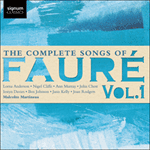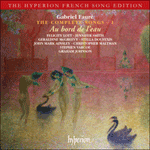This poem is entitled
Lamento in Gautier’s
La comédie de la mort (1838). Berlioz’s setting is entitled
Sur les lagunes (from
Les nuits d’été) and dates from 1856. Fauré first came into contact with Gounod in 1872 and both composers set this poem in that year, Gounod under the title
Ma belle amie est morte. Apart from repetitions of the phrase ‘sans amour’ Fauré avoids the verbal meanderings of Gounod who also shamelessly cuts Gautier’s text. If Fauré fails to match the anguish of Berlioz at his height he writes a highly effective song in the Italian manner. It was immediately taken up by Madame Lalo, although its dedicatee, Pauline Viardot, took some time to include it into her repertoire. If the opening gives the impression of an unaccompanied recitative
senza misura it is evident, even at this early stage, that exactness of rhythm is a vital component of the composer’s musical planning. Fauré reflects the narrator’s solitary grief in harmonies that suggest the emptiness of bereavement and an unsettled state of mind. At the song’s opening the intermittent triplets of the accompaniment suggest the plying of a fisherman’s oar in the lagoons rather than the dipping and plunging of a larger vessel. As the song gets into its stride the words tumble more readily from the singer’s lips and an initially compressed emotional horizon broadens into a grieving seascape. Fauré returned to this work a quarter of a century later to orchestrate it.
from notes by Graham Johnson © 2005
Encore un poème de Gautier que la musique rendit célèbre. La mise en musique de Berlioz, intitulée
Sur les lagunes (extraite de
Les nuits d’été), date de 1856. Celle de Gounod – connue sous le titre
Ma belle amie est morte – date, comme celle de Fauré, de 1872, année où les deux hommes entrèrent en contact pour la première fois. Hormis la répétition des mots «sans amour», Fauré évite les méandres verbaux de Gounod, par ailleurs coupable de coupes éhontées dans le texte, et, même s’il ne parvient pas à égaler l’angoisse de Berlioz à son apogée, il n’en écrit pas moins une mélodie fort efficace, à la manière italienne, que Mme Lalo reprit immédiatement, tandis que sa dédicataire, Pauline Viardot, mit un certain temps à l’inscrire à son répertoire. Si l’ouverture donne l’impression d’un récitatif non accompagné
senza misura, il est évident, même à ce stade précoce, que l’exactitude rythmique est une composante vitale du plan musical fauréen. Fauré traduit la douleur solitaire du narrateur par des harmonies qui reflètent la vacuité du deuil et un état d’esprit perturbé. Au début de la mélodie, les triolets intermittents de l’accompagnement évoquent davantage un pêcheur ramant dans les lagunes qu’un grand vaisseau tanguant et piquant du nez. À mesure que la mélodie trouve son rythme, les mots roulent plus aisément des lèvres de l’interprète et l’horizon émotionnel initialement comprimé s’élargit en un paysage marin de deuil. Au bout d’un quart de siècle, Fauré reprit cette œuvre pour l’orchestrer.
extrait des notes rédigées par Graham Johnson © 2005
Français: Hypérion


 Fauré: The Complete Songs, Vol. 1
Fauré: The Complete Songs, Vol. 1 Fauré: The Complete Songs, Vol. 1 - Au bord de l'eau
Fauré: The Complete Songs, Vol. 1 - Au bord de l'eau
